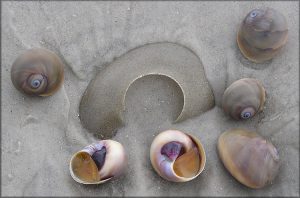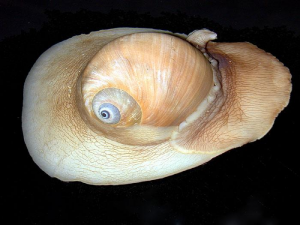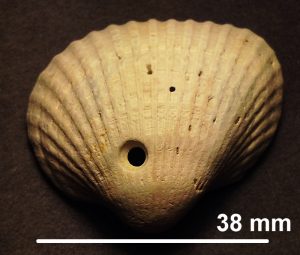
Walking along local beaches, you are almost sure to find something interesting washed up on the sand. Shells, of course, are the most common find, and their vast diversity of colors and shapes is fascinating. Seagrasses and sargassum typically wash in with the waves, and can be found at the wrack (high tide) line. There’s always some trash, sadly, and I encourage you to pick any you see to prevent animals from accidentally ingesting it and causing themselves harm.

And then, there are the living organisms you see on the shoreline; crabs, mussels, hopping amphipods and insects, and an endlessly bizarre collection of other invertebrates and their accoutrements. It’s usually the weird, squishy stuff that I get calls and emails about–sea hares, sea squirts, unusual jellyfish, and egg cases.
Today’s feature is one of those such invertebrates. The organism itself is not so unfamiliar—a palm sized snail with a smooth tan, gray, and white striped shell. The moon snail, aka shark eye, (Neverita duplicata) is quite common, and often reused by hermit crabs. What causes more intrigue is its egg case. In previous blogs, I’ve written about the wide variety and unusual form of egg cases, and this is no different.

The adult moon snail is a fascinating creature—it has a huge, muscular foot and glides just below the surface of the sand, as deep as its siphons will allow. While moving, it pushes sand around its body and leaves a recognizable trail. Moon snails are predators of smaller clams, and are responsible for those circular holes found in many shells along the beach. To feed, it holds a clam with its foot and uses a boring organ (complete with hydrochloric acid) to soften the clam’s shell. Once softened, it uses its radula (a rugged tongue) to drill a hole in the shell, stick its proboscis inside, and slurp up the clam meat. Some faster-moving prey can escape the moon snail after it has started drilling, but many clam shells strewn along the beach show the scars of a moon snail run-in.

The moon snail egg case is a curious structure. The snails lay eggs in a mucous capsule that surrounds their bodies and mixes with the adjacent beach sand grains. The result is a sandy, gelatinous egg case with a half-circle shape. It is soft and flexible but firm enough to be picked up, often described as plastic-like. They are referred to as “sand collars,” as the shape left behind once the moon snail has moved on closely resembles a shirt collar. The sand collars are full of thousands of egg capsules, holding embryos. Once the eggs hatch and swim away, the sand collar breaks down.
 5
5
